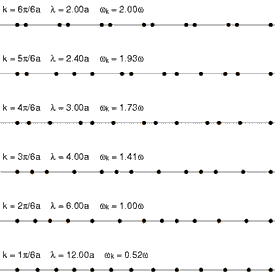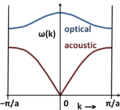Phonon facts for kids
In physics, a phonon is a tiny packet of energy related to how atoms vibrate in a solid material. Think of it like a sound wave, but instead of traveling through air, it travels through the atoms of a crystal.
The word quantized means that something can only have specific, fixed values. Imagine climbing stairs: you can only stand on a step, not in between. That's what "quantized" means for phonons. Their vibrations can only happen at certain frequencies, not just any frequency.
A lattice is the repeating pattern of atoms or molecules in a crystal. Crystals are like building blocks arranged in a very neat, repeating way. The points where these atoms or molecules sit form the lattice.
Contents
What are Phonons?
Phonons are like tiny bundles of energy that carry heat and sound through solid materials. When atoms in a crystal vibrate, they don't just jiggle randomly. They move in organized ways, and these organized movements are what we call phonons.
Why are Vibrations Quantized?
You might wonder why these tiny vibrations are quantized. When you shake a large object, it can vibrate at almost any speed. But when we look at the super tiny world of atoms in a crystal, things change.
Because atoms in a crystal are arranged in a very specific, repeating pattern, their movements are linked. When scientists use quantum mechanics to study these linked movements, they find that only certain vibration frequencies are allowed. It's a bit like how a guitar string can only make certain notes, not just any sound.
How Phonons Move Heat
Phonons are very important for how heat moves through solids. When you touch something hot, the atoms in that object are vibrating a lot. These vibrations create phonons, which then bump into other atoms, making them vibrate too. This is how heat energy spreads from one part of the material to another.
For example, metals are good at conducting heat because their atoms are tightly packed and can easily pass on these phonon vibrations. Materials like wood are not as good because their structure makes it harder for phonons to travel quickly.
Phonons and Sound
Just like they carry heat, phonons also carry sound through materials. When you tap on a table, the sound you hear is caused by vibrations traveling through the table's material. These vibrations are made of phonons.
When sound waves hit a solid object, they make the atoms in that object vibrate. These vibrations create phonons that travel through the material, carrying the sound energy. This is how sound can travel through walls or the ground.
Types of Phonons
There are different types of phonons, depending on how the atoms vibrate.
- Acoustic phonons: These are the most common type. They are responsible for carrying sound and heat. In acoustic phonons, all the atoms in a small area move in the same direction, like a wave.
- Optical phonons: These happen in crystals with more than one type of atom. In optical phonons, different atoms in the same area move in opposite directions. They are called "optical" because they can interact with light.
Understanding phonons helps scientists create new materials with special properties, like materials that are very good at blocking heat or materials that can convert heat into electricity.
Images for kids
See also
 In Spanish: Fonón para niños
In Spanish: Fonón para niños






